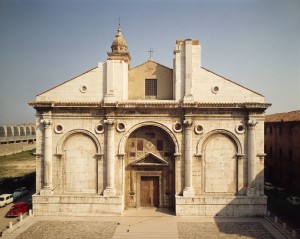![Matteo de’ Pasti<br />Medal of Leon Battista Alberti (1404–72), Architect and Writer on Art and Science [obverse]; Winged Human Eye [reverse], 1446/50<br />Bronze, diameter 9.3 cm (3 11/16 in.)<br />National Gallery of Art, Washington, DC, Samuel H. Kress Collection<br />Image courtesy of the Board of Trustees, National Gallery of Art](http://italianrenaissanceresources.com/wp-content/uploads/2013/03/RP_1321-1.jpg)
Matteo de’ Pasti
Medal of Leon Battista Alberti (1404–72), Architect and Writer on Art and Science [obverse]; Winged Human Eye [reverse], 1446/50
Bronze, diameter 9.3 cm (3 11/16 in.)
National Gallery of Art, Washington, DC, Samuel H. Kress Collection
Image courtesy of the Board of Trustees, National Gallery of Art
Alberti, who commissioned this medal, represents to perfection the new age. Born into the upper-class culture of fifteenth-century Florence, he immersed himself in the learning exemplified by the recovered texts of ancient authors. Known to a later age as humanists—that is, students of the liberal arts, or “humanities”—scholars were actively engaged in bringing back into circulation the works of ancient Roman authors, such as Cicero, Virgil, and the historians Livy and Tacitus. As a youth, Alberti studied the antique literary texts that had been circulating in Italy since the early years of the fifteenth century. Of equal interest were the recent developments in Florentine painting, architecture, and sculpture, exemplified for Alberti by the works of Masaccio, Brunelleschi, and Donatello. Alberti wrote, in Latin, De pictura (1435), a treatise on the art of painting, which he then translated into Italian as Della pittura (1436). Alberti’s preface to Della pittura praised the painters of Renaissance Florence as equal to, if not surpassing, the ancients (see “Alberti praises the painters of Florence”). Reaching far beyond the how-to approach of earlier manuals, Della pittura casts painting in classical terms, as an art that is part natural science, part poetics, and part rhetoric. Alberti’s presentation of what painting could do—that is, give works of art the status and high purpose accorded to the literary arts—was eagerly consulted by painters and patrons:
Painting contains a divine force which not only makes absent men present, as friendship is said to do, but moreover makes the dead seem almost alive. Even after many centuries they are recognized with great pleasure and with great admiration for the painter. . . . Some think that painting was shaped by the gods who were adored by the nations. It certainly was their greatest gift to mortals.3
![After Matteo de’ Pasti<br /><i>Medal of Sigismondo Pandolfo Malatesta San Francesco at Rimini</i> [reverse], 1450<br />Bronze, diameter 4 cm (1 9/16 in.)<br />National Gallery of Art, Washington, DC, Samuel H. Kress Collection<br />Image courtesy of the Board of Trustees, National Gallery of Art](http://italianrenaissanceresources.com/wp-content/uploads/2013/02/RP_126-300x282.jpg)
After Matteo de’ Pasti
Medal of Sigismondo Pandolfo Malatesta San Francesco at Rimini [reverse], 1450
Bronze, diameter 4 cm (1 9/16 in.)
National Gallery of Art, Washington, DC, Samuel H. Kress Collection
Image courtesy of the Board of Trustees, National Gallery of Art
As Alberti’s medal makes clear, the action of the eye in seizing upon and absorbing information played a fundamental role in the new world of learning. Reading and book knowledge were seen as one important road in the pursuit of knowledge. But Alberti and many others like him realized that information derived from visual sources—painting, sculpture, and pictorial images of all kinds—was to be placed right alongside literary material. The new valuation of visual artifacts as transmitters of complex and rich ideas is one of the central features of the period and did much to shape the creative imagination.
